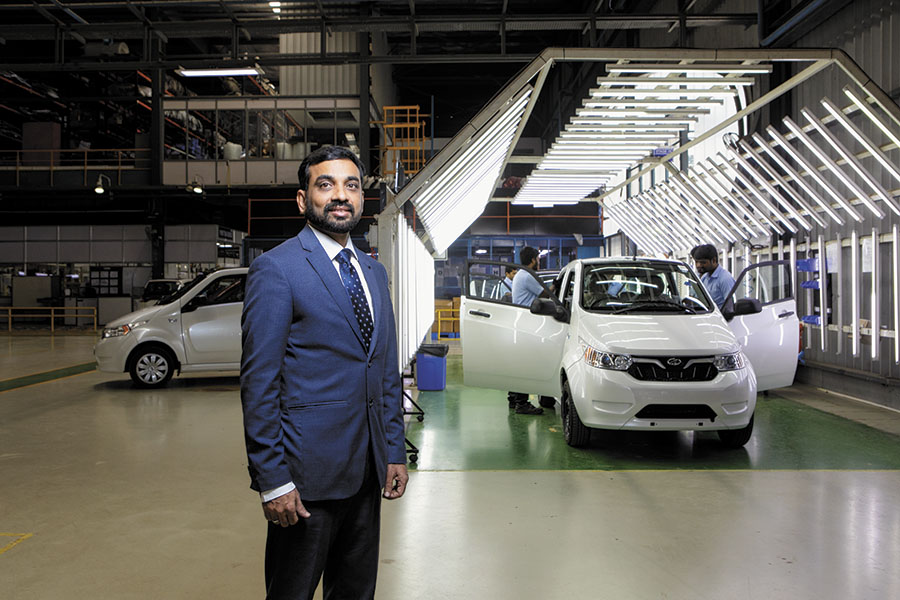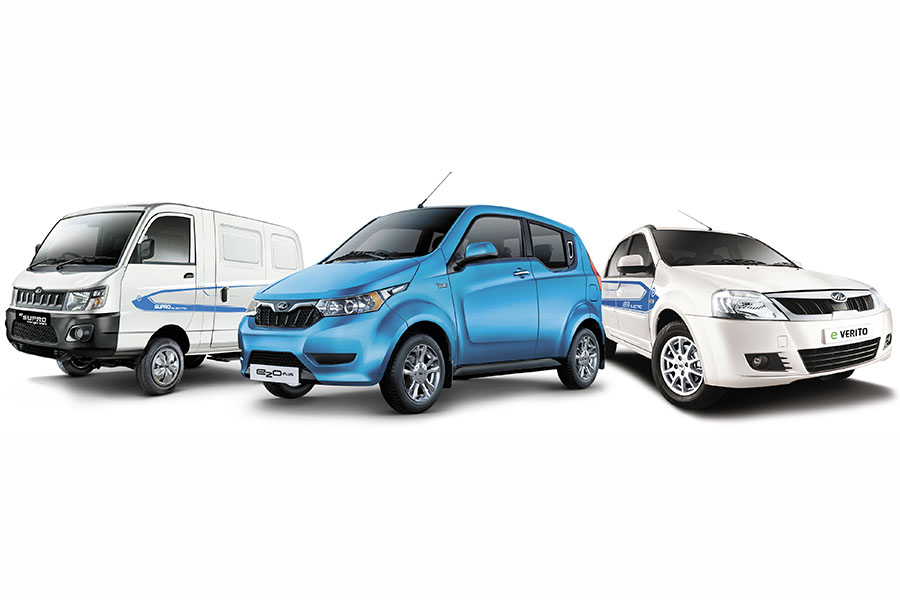
Mahindra & Mahindra: First mover & shaker
Mahindra & Mahindra placed its bets on electric mobility as early as 2007. A decade later, the move appears to be paying off
 Mahesh Babu S, CEO, Mahindra Electric says India can become the second largest EV market in the world between 2030 and 2040
Mahesh Babu S, CEO, Mahindra Electric says India can become the second largest EV market in the world between 2030 and 2040
Image: Selvaprakash Lakshmanan for Forbes India
Mahesh Babu S is a sought-after man these days. In the last 2-3 months, the 46-year-old chief executive of Mahindra Electric Mobility has received a multitude of requests from startups that want to launch a mobility solutions venture using electric vehicles (EV). “Earlier, it was probably one request a month; now it is five to 10,” says Babu, whose company is a pioneer in the Indian EV space.
The heightened interest among startups looking to partner with Mahindra Electric—an arm of the $19-billion conglomerate, Mahindra and Mahindra (M&M)—isn’t surprising. It is logical considering the government has made up its mind to boost the adoption of EVs in the country through policy support (which opens up new entrepreneurial possibilities) and Mahindra Electric is a distinct first mover in this space.
The watershed moment for the future of EVs in India came in May 2017 when the government announced that it wants to ensure that all vehicles sold in India by 2030 would run on electricity, as opposed to the internal combustion engine-driven cars plying at present, which burn petrol and diesel. The rationale behind switching to EVs is the worsening air quality of top Indian cities, including the National Capital Region and Mumbai, as well as a rising import bill on account of crude.
The aggression with which the Indian government is promoting battery-powered EVs is evident from the deadline it has set, which is a decade earlier than the year by which Britain aims to make a similar shift.
“If the policy actions that are being contemplated materialise, India has the potential to become the second largest EV market in the world between 2030 and 2040,” says Babu, who has spent 19 years with M&M.
M&M chairman Anand Mahindra and its managing director Pawan Goenka had perhaps anticipated this inevitable shift towards newer and cleaner automotive technology in 2007. That was the year when M&M decided to acquire a majority stake in Bengaluru-based Reva Electric Car Co, a small-yet-ambitious EV company started by Chetan Maini, which rolled out its eponymous car in 2001.
Though EV sales in India have been subdued due to lack of charging infrastructure, high-cost batteries leading to expensive vehicles, and range anxiety (a concern on the part of an EV user that the battery will run out of charge before reaching a charging station), M&M persisted with its investments in Reva (which was first rebranded as Mahindra Reva Electric after the acquisition, and then Mahindra Electric in 2016). According to reports, Mahindra has committed close to $700 million for its EV project—which includes manufacturing vehicles, drivetrain and assembling battery packs—which is further to the carmaker’s goal of ensuring zero tailpipe emission in the country.
In FY17, Mahindra Electric sold 1,500 cars and it expects the figure to touch 2,000 by the end of FY18, according to Babu. Though the volumes aren’t significant yet (M&M sold 2,42,047 vehicles in the first half of the current fiscal), there is every indication that Mahindra is gearing up for a disproportionate rise in the number of EVs it sells in India going forward. “We expect volumes to pick up and I am confident that it is possible for us to achieve 5x growth in FY19,” Babu tells Forbes India.

(L to R) Mahindra Electric’s eSupro commercial van, E2O Plus hatchback and the e Verito sedan
Suman Jagdev, senior director with consulting firm Alvarez & Marsal, says Mahindra is well placed in the EV space, having been a first mover. As the EV ecosystem and infrastructure evolves, Mahindra is expected to capitalise on future growth opportunities. “They seem quite focussed on the direction and capabilities required to build the EV business,” Jagdev says.
At present, Mahindra Electric has five offerings in its stable. There are the three passenger vehicles—the E2O and E2O Plus (hatchbacks) and the e Verito (the electric version of the Verito sedan)—apart from eSupro (a commercial van) and e-Alfa Mini (an electric three-wheeler). Mahindra Electric is also working on plans to launch electric versions of other petrol and diesel cars in M&M’s portfolio and intends to launch six products by 2020, including those for last-mile connectivity (like vans and e-rickshaws) in cities, SUVs and public transport buses.
“Our strategy would be to electrify some of our existing products that fit well with customers’ needs, make an electric version of all new platforms that Mahindra develops in the future, and then look at how aspirational products with partners like Pininfarina and others will make business sense,” says Babu.
A significant portion of the incremental volumes that Mahindra expects, in the short-term, is likely to come from a government tender to procure EVs. In August 2017, state-run Energy Efficiency Services Ltd (EESL) had floated a tender to procure 10,000 EVs for government use. Tata Motors was the lowest bidder for the project (bidding an all-inclusive price of ₹11.2 lakh). In the first phase of 500 cars, for which deliveries are ongoing, Mahindra agreed to match Tata Motors’ price and supply 150 cars. In the second phase, out of the remaining 9,500 cars, Tata Motors will be supplying around 4,500 vehicles. Mahindra Electric and other carmakers will have the option of matching Tata Motors’ price to pick up the remaining portion of the order. Mahindra has already stated its intention of matching Tata Motors’ price, but the quantum of cars it is willing to supply isn’t known.
n FY17, Mahindra Electric sold 1,500 cars and it expects the figure to touch 2,000 in the current fiscal
Government orders are only a part of the EV growth story that Mahindra is betting on. Mahindra Electric’s keenness to work with startups and large cab aggregators arises from its belief that the adoption of EVs in the country will be led by fleet operators who offer mass mobility solutions. Which is why on the one hand it is working with established players like Ola, Uber, Zoomcar and BigBasket by supplying EVs for use in cities like Delhi, Nagpur, Mysore and Hyderabad and on the other it is partnering with startups like Lithium Urban Mobility in Bengaluru, which uses E2O and E2O Plus cars and fast charging stations provided by Mahindra Electric to run an electric cab service for office-goers.
“The easiest way for EVs to become viable is when they are used as part of a fleet,” says Babu. “The operating expenditure is low and even if the capex to acquire these cars is high, it can be recovered in one to two years.”
Though sceptical of the adoption of EVs on the part of private car owners in the near future, Gaurav Vangaal, senior analyst, automotive forecasting–light vehicles, IHS Markit, agrees that targeting the cab market with EVs makes sense. “There are battery and infrastructure issues when it comes to EVs around the world, which is why their penetration isn’t 100 percent anywhere,” Vangaal says. “But owning and operating EVs makes sense for cab aggregators since they purchase in bulk. But even though running costs are lower, cab owners will look at them seriously only if they get incentives from the government.”
Vangaal says for EVs to become successful in India, domestic carmakers will need to look at “frugal innovation”. Mahindra knows this. It is aware that for its business to be sustainable, an entire ecosystem needs to be developed, which will make EVs affordable and convenient for owners. And this is where Mahindra Electric’s EV 2.0 strategy fits in.
In May 2017, Mahindra unveiled its new strategy for electric mobility that entails the development of innovative solutions under three pillars: Products (explained earlier), technology and mobility solutions. Under technology, Mahindra Electric seeks to develop new drivetrains with higher efficiency, batteries with higher density (leading to higher performance) and fast charging mechanisms (which can reduce the time taken to fully charge the battery to under an hour). Vis-à-vis mobility solutions, Mahindra Electric is working with other stakeholders such as SIAM (Society of Indian Automobile Manufacturers), mall and office developers and the government to develop and connect charging stations, traffic management systems, vehicles and drivers.
Babu says one way by which EVs can be made more appealing is to create charging spots across cities where car owners won’t have to waste their time. “For instance, can we get restaurant owners or mall and office developers to reserve a certain portion of their parking space, equipped with charging stations, for EVs,” he says.
Babu observes that any sunrise business reaches a tipping point when a few factors fall into place simultaneously. That seems to be happening. The cost of lithium-ion batteries is coming down globally. Jagdev states that these batteries have become 40-50 percent cheaper in the last three to four years owing to technology improvements and economies of scale. Prices are also expected to reduce further to $100 per kilowatt-hour in the next decade, which is when EVs as a proposition start to become competitive with conventionally powered vehicles. The cost of these batteries is currently estimated at $180-200.
Simultaneously, the impending government policy on EVs and the potential incentives therein will also play a role in helping such vehicles find favour. Vangaal points out that an attractive EV policy will drive foreign carmakers, especially the Chinese, to look at India seriously, leading to heated competition. When that happens, well-entrenched local players like Mahindra will hope to protect their home turf on the back of their present investments.
(This story appears in the 16 February, 2018 issue of Forbes India. To visit our Archives, click here.)














